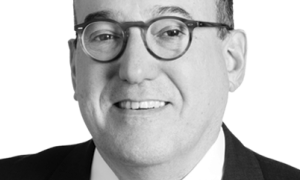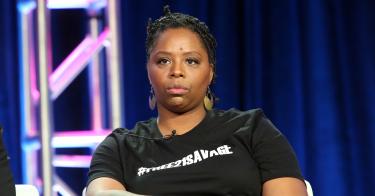The relationship between Palestinians and the global Marxist networks that birthed Black Lives Matter has an old pedigree. Palestinian activists were in Ferguson, Missouri, in 2014, when BLM was forged into a global movement. But their ties with BLM’s architects actually precede BLM’s founding.
This is something that must be borne in mind by people who—still, to this day, somehow—appear confused as to why BLM organizations defend the killing spree and gang rapes carried out by the Palestinian terrorist group Hamas in Israel on Oct. 7.
Ferguson is key. Palestinians were very much involved on the streets of Ferguson soon after Officer Darren Wilson shot Michael Brown on Aug. 9, 2014, in that St. Louis suburb. There were Palestinian activists already there during that first month, and the Palestinian flag was flown at the first major “national” march on Aug. 30.
Steve Tamari, a professor of Middle East history at Southern Illinois University Edwardsville, wrote that December of how he had run up to a black marcher waving the flag and said, “Hey, that’s my flag,” and the man replied, “This is our intifada.”
>>> BLM’s Support of Hamas Is Perfectly in Line With Its Goals
Riots rocked the impoverished community for the rest of the year in scenes that shocked the country. In the meantime, and more importantly, BLM founders Alicia Garza and Patrisse Cullors and other activists were shrewdly using Ferguson to interconnect and organize a global web.
They brought to Ferguson leftists from across the country, chiseled a structure, and determined that this new national and global network would focus revolution on the lie that police kill black people in disproportionate numbers.
Less than two years later, in one of the early hagiographies of the movement’s creation, the New Yorker’s Jelani Cobb wrote that the activists “coordinated ‘freedom rides’ to Missouri” from all over the country. “Within a few weeks of Brown’s death, hundreds of people who had never participated in organized protests took to the streets.”
Garza described to Cobb that those activists “pushed us to create a chapter structure. They wanted to continue to do this work together.”
Some activists came from much farther afield. According to Tamari, the Palestinian contingent was 200-strong and had its own superstar leaders. Among those who spoke were firebrands Linda Sarsour, Suhad Khatib, and artist Remi Kanazi, who performed at an Oct. 12 rally with Cornel West.
There was another Palestinian delegation that met with the Ferguson organizers, the Right to Education Campaign, composed of students from five universities in the West Bank and the Gaza Strip. Put at 10 by some reports, the delegation made it to Ferguson in mid-November, as the activists and rioters, still encamped in the city, nervously awaited whether a grand jury would indict Officer Wilson (it didn’t).
“We tried to connect the dots between the struggles between the African American society and the Palestinians,” one of the Palestinians, Mahmoud Daghlas, said.
They had three goals: The first—to “create linkages between the student movement in the U.S. and Palestine”; second—to “build long-term, institutional relationships between our universities”; and third—to “exchange information between Palestinians and U.S. social movements.”
The networking paid immediate dividends. Six weeks later, Cullors led a delegation of Ferguson organizers to the West Bank, from where they issued strongly worded anti-Israeli statements.
“I believe the Black Lives Matter movement can benefit greatly by learning about struggles outside of the U.S., but particularly the Palestinian struggle,” Cullors said. “I want this trip to be an example for how black folks and Arab communities can be in better solidarity with one another.”
Her visit was organized by the group Dream Defenders, which even the very “woke” Anti-Defamation League says associates with the Popular Front for the Liberation of Palestine. The director of national intelligence calls the Popular Front “a Syria-based terrorist group.”
>>> How Marxist Left Captured Higher Education
The Palestinian student delegation that visited Ferguson in late 2014 was, meanwhile, organized by the group National Students for Justice in Palestine, which organized this month the most antisemitic student demonstrations in support of the Hamas massacre.
In fact, an SJP toolkit refers to the Hamas atrocity as “Operation Al-Aqsa Flood” and says, “We as Palestinian students in exile are PART of this movement, not in solidarity with this movement.” On the strength of that, Gov. Ron DeSantis (R-FL) has ordered state universities to disband SJP chapters.
But Palestinian groups networked with Cullors, Garza, and others well before Ferguson. In 2007, seven years before Ferguson, Palestinians participated in the opening in Atlanta of the U.S. Social Forum, a gathering node of the international Left that was then setting roots in the U.S. The USFF issued a declaration calling the creation of the state of Israel a “catastrophe,” which had led to “ethnic cleansing.” Garza, then only 26, was there, too, leading a delegation of 30 black and Hispanic activists.
Cullors played a key role in the USFF conferences that took place later on. In 2010, in Detroit, she participated in several panels. Palestinian activists gathered there succeeded in getting the forum to cancel a workshop that pointed out the truth—that Israel was the Middle East’s only “safe haven for LGBTQI communities” because that fact would undermine support for the Palestinian territories.
Cullors, Garza, Opal Tometi, Melina Abdullah, and other BLM luminaries were thus immersed in the ideology that Israel is the oppressor, another white settler-state just like the U.S., well before they founded BLM in 2013 and created a network in Ferguson in 2014.
This background makes it all too clear why they rejoiced in the carnage of 2023.
This piece originally appeared in Restoring America by the Washington Times




